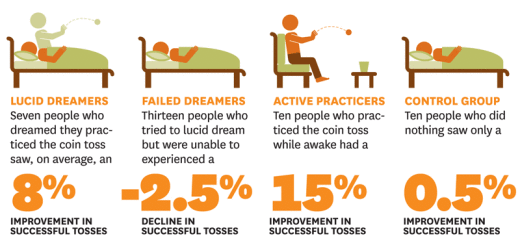
Imagine falling asleep and being able to pick up writing tips from Hemingway, hit tennis balls with Serena Williams, or pitch your startup to Peter Thiel knowing you can carry these very skills and experiences into waking life.
Imagine being able to fly, relax on a beach, or even calm your anxiety and fight off nightmares.
For centuries, human beings have been looking to the dream state as a pathway to higher knowledge, creativity, and self awareness.

Dreams have been studied and practiced by everyone from the ancient Hindus and Greek philosophers to pioneers such as Nikola Tesla and Salvador Dali, filmmakers Guillermo Del Toro, James Cameron, and Chris Nolan, and authors Tim Ferriss and Stephen King.
“Dreams are a reservoir of knowledge and experience, yet they are often overlooked as a vehicle for exploring reality.” — Tibetan Buddhist Tarthang Talk
Can we actually control our dreams?
For most of us, dreaming is a spectator sport. We sit on the sidelines while images and ideas fly past us and if we’re lucky we’ll be able to remember a few when we wake up. But what if you were able to actively control the path of your dreams?
As the founder of the Lucidity Institute, Stephen LaBerge is one of the leading clinical researchers on lucid dreaming —the idea that we can be conscious of and even control our dreams.
While at Stanford, LeBerge conducted a study where trained lucid dreamers were instructed to perform a specific set of eye movements (i.e. Right-Right-Left-Right-Left) upon becoming aware of their dream state. Polygraph machines monitored their eye movements, which consistently matched the predetermined patterns.
Researchers could actually see the sleepers’ eye movements transition from rapid and random to slow and controlled, proving that humans do have the ability to control cognitive functions during sleep.

In his book, Exploring the World of Lucid Dreaming, LaBerge goes on to argue that lucid dreaming isn’t simply about creating wonderful, surreal experiences (which is fabulous in and of itself), but that gaining control of our dreams can improve our waking lives in profound ways by boosting our creativity & problem solving, accelerating learning, overcoming fears, helping us to become better decision makers, and reducing stress and finding inner presence and mindfulness.
“Once you have had the experience of realizing that you are dreaming and that your possibilities are far greater than you had thought, you can imagine what a similar realization would be like in your waking life.” — Stephen LaBerge
How lucid dreaming can improve our skill development
Most of us have heard of the benefits of visualization and mental rehearsal on performance, but sleep researchers now believe lucid dreaming can be an even more powerful form of mental imagery as we make use of all our senses to create vivid environments that facilitate the reinforcement and learning of skills.
To illustrate how this works, consider these two studies by Dr. Daniel Erlacher of the University of Bern:
- A group of lucid dreamers, who were asked to perform a series of deep knee bends while asleep saw small but noticeable increases in heart and respiration rates.
- Subjects were tested on their ability to toss coins into a cup placed two meters away. They were then divided into groups and instructed to either practice the toss, dream they were practicing the toss, or do nothing. Afterwards, the “active practicers” saw a 15 percent increase in successful tosses, the dreamers saw an eight percent increase, and the control group improved by just 0.5 percent.

The physical manifestations occur because in the lucid state, the brain delivers the same messages to your muscles and the rest of your body as if it the actions were real, but your muscles don’t move because they’re paralyzed by the REM process.
Beyond improving motor skills, lucid dreaming can be used to rehearse for just about anything in life: an important meeting, a big presentation, a surgical procedure, or a difficult conversation.
That’s why you can experiment with different things without fear of injury, fatigue, or embarrassment. You set up a practice environment that allows you to test your limits and push yourself, and develop those same neural pathways without actually moving a muscle.
How to boost your creativity while you’re asleep
We all have a treasure trove of information, memories, and experiences stored in the warehouse that is our subconscious mind, most of which our conscious brain classifies as irrelevant (and consequently inaccessible).

When we do creative work, however, we want to tap into the part of our brain that allows us to think in a more associative and divergent manner. It’s why we sleep on things and take a step back and pray for divine intervention. And, it’s why our dreams can be such a powerful tool for bringing these pieces of our subconscious to the surface—so long as we learn to effectively make sense of the ideas upon waking.
“What The Subconscious is to every other man, in its creative aspect becomes…The Muse.” -Ray Bradbury
Sometimes all it takes is the ability to recall the dream, the way that Paul McCartney composed the entire melody of Yesterday after a very vivid dream. Most of the time though, we have to be intentional about problems we want to solve so that we can create the subconscious playground in which to find the answer.
In Hacking Creativity, Steven Kotler writes of inventor and futurist Ray Kurzweil who uses lucid dreaming to solve complex technical, business, or even personal problems, where he imagines coming up with a solution at night before drifting off to sleep.
“All night, snippets of the solution filter in and out of his dreams. At the first glimmer of consciousness, Kurzweil returns to the problem. It is then, during the brief quasi-conscious state known as ‘lucid dreaming’, that he merges the logic of his conscious thought with the relaxation of inhibition engendered by his dreams to arrive at many of his most startling insights.”
Kotler concludes that the key to lucid dreaming lies in simple pattern recognition, where if we can learn to relax our bodies and minds to focus on a particular problem or benefit, the deeper parts of our brain can then go to work connecting information in new and different ways.

How to induce lucid dreaming
If the idea of using your sleeping hours to build your confidence and become more creative sounds good there are measures you can take to start learning how to control your dreams.
I like to compare lucid dreaming to a mindfulness practice because it has everything to do with being conscious about the things in and around us. The definition of lucid dreaming, after all, is the ability to be aware that you’re dreaming, so many of the techniques outlined below revolve around developing your ability to keep your thoughts focused and be hyper aware of your environment and how you interact with it.
1. Practice dream recall
Keep a journal beside your bed and write down everything you can remember immediately upon waking, starting with little clues or thoughts and build from there. Work up to a point where you can remember at least one dream per night in as much detail as possible, so that you can paint a clear picture of the kind of dreams you frequently have and then recognize them while they’re happening.
2. Identify your dream signs
Once you have 7–12 dreams recorded look for patterns—the odd things, people, or places that make regular appearances. Identify your common dream signs which you’ll later be using as target gateways to enter a lucid state.
3. Test your reality
As you go about your day, pay attention to things that happen to and around you, especially anything resembling one of your dream signs. The goal is to test your reality so often that eventually, out of habit, you do it while dreaming.

For example, look at objects and notice their patterns, colors, and textures. Look away and then look back, making sure that everything is the same. Throughout the day, ask yourself simple questions like:
Am I dreaming or awake? How do I know? What am I wearing? What’s my name? Where am I? What happened five minutes ago?
In a dream world, objects, texts, events and people have a funny way of changing shape and form right before our eyes.
4. Induction
As you’re drifting off to sleep, consider the following relaxation and induction exercises:
- Relax with a series of progressive relaxation exercises, where you release all tension from your body and clear your mind from the day’s worries so that you can focus on your intention.
- Set your intention: Resolve to be aware of your dream state with a prayer or affirmation.
- Rehearse the dream: Visualize your intention over and over as you’re falling asleep, where you imagine yourself in a lucid dream — whatever benefit you’re seeking or problem you’re trying to solve, that should be your intention as you are falling asleep.
5. Split your sleep cycle up
Many lucid dreamers find success splitting their sleep into two sessions where they sleep for 5–6 hours, wake up for an hour, and then go back to sleep and apply the induction techniques. This is because longer, more vivid dreams happen later, which is when we have more REM sleep.

These exercises get frustrating very quickly, especially when after so many weeks of diligent practice, I still fail to recognize that I’m dreaming and enter a lucid state.
But I keep at it because I want my sleeping hours to become my personal virtual reality arena, where I can find my creative edge, learn new things, talk to interesting people, and change the bizarre and negative images I encounter into beautiful and inspiring ones.
At the very least I’d really like to be able to fly.
Read Next: 5 creativity myths you need to stop believing
Image credit: Shutterstock, Dyaa Eldin, Harvard Business Review
This post first appeared on Crew.
Get the TNW newsletter
Get the most important tech news in your inbox each week.
